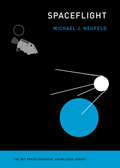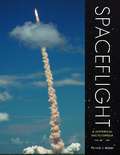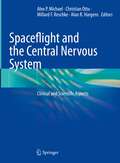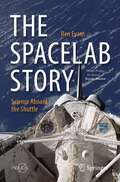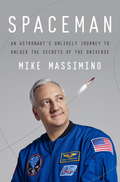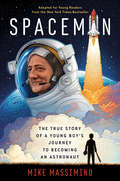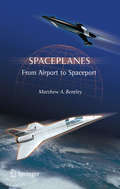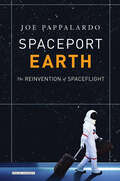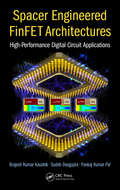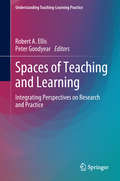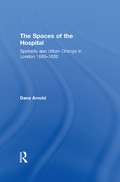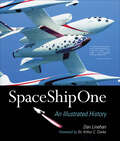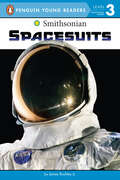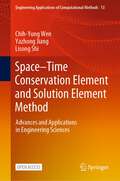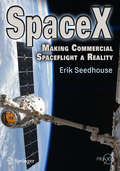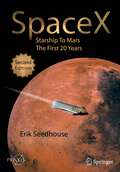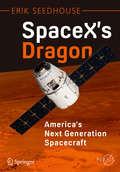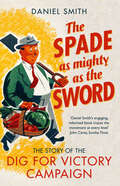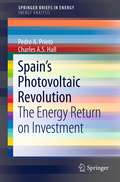- Table View
- List View
Spaceflight: A Concise History (The MIT Press Essential Knowledge Series)
by Michael J. NeufeldA concise history of spaceflight, from military rocketry through Sputnik, Apollo, robots in space, space culture, and human spaceflight today. Spaceflight is one of the greatest human achievements of the twentieth century. The Soviets launched Sputnik, the first satellite, in 1957; less than twelve years later, the American Apollo astronauts landed on the Moon. In this volume of the MIT Press Essential Knowledge series, Michael Neufeld offers a concise history of spaceflight, mapping the full spectrum of activities that humans have developed in space. Neufeld explains that “the space program” should not be equated only with human spaceflight. Since the 1960s, unmanned military and commercial spacecraft have been orbiting near the Earth, and robotic deep-space explorers have sent back stunning images of faraway planets. Neufeld begins with the origins of space ideas and the discovery that rocketry could be used for spaceflight. He then discusses the Soviet-U.S. Cold War space race and reminds us that NASA resisted adding female astronauts even after the Soviets sent the first female cosmonaut into orbit. He analyzes the two rationales for the Apollo program: prestige and scientific discovery (this last something of an afterthought). He describes the internationalization and privatization of human spaceflight after the Cold War, the cultural influence of space science fiction, including Star Trek and Star Wars, space tourism for the ultra-rich, and the popular desire to go into space. Whether we become a multiplanet species, as some predict, or continue to call Earth home, this book offers a useful primer.
Spaceflight: A Historical Encyclopedia, Volume 2 (H-R)
by Patrick J. WalshThis book is a comprehensive history of the first six decades of space exploration, from the end of World War II to the modern era of routine international cooperation in space.
Spaceflight: A Historical Encyclopedia, Volume 1 (A-G)
by Patrick J. WalshThis book is a comprehensive history of the first six decades of space exploration, from the end of World War II to the modern era of routine international cooperation in space.
Spaceflight: A Historical Encyclopedia, Volume 3 (S-Z)
by Patrick J. WalshBeginning in the 1950s, spaceflight's history spans about a half a century--a short history, but profound in its cultural and technological impact and the level of resources involved. Evidently bound by love to the study, Walsh has assembled this three-volume reference, which includes entries on every space mission, both human and robotic, and is distinguished, also, by a substantial number of biographical entries covering astronauts, Russian cosmonauts, and other non-US, and non-Russian cosmonauts. Arranged alphabetically, the 699 entries are enhanced with small b&w photos; a chronology, a bibliography, and a comprehensive index appear in the third volume. Clear, accessible writing and comprehensive coverage make this a useful and engaging reference that will serve a wide audience of students and the general public as well as industry workers interested in the context and history of their endeavors. Annotation ©2010 Book News, Inc., Portland, OR (booknews.com)
Spaceflight and the Central Nervous System: Clinical and Scientific Aspects
by Alex P. Michael Christian Otto Millard F. Reschke Alan R. HargensThis book consolidates the current knowledge of how short and long-duration spaceflight affects the anatomy and physiology of the central nervous system. It also incorporates the methodology and constraints of studying the central nervous system in space. Chapters detail advances in imaging techniques available to assess intracranial and intraocular pathology as well as translational medicine with an emphasis on brain cancer and neurodegenerative disease in spaceflight. Additionally, the book offers theoretical background information, tested laboratory protocols, and step-by-step methods for reproducible lab experiments to aid neuroscientists and neurobiologists in laboratory testing and experimentation. Spaceflight and the Central Nervous System is the first to comprehensively include all aspects of spaceflight-induced changes in the central nervous system. It is an invaluable resource for basic and clinical laboratory trainees and researchers in aerospace medicine and physiology or for those looking to gain specific knowledge in spaceflight neuroscience.
Spaceflight in the Shuttle Era and Beyond: Redefining Humanity's Purpose in Space
by Valerie NealAn exploration of the changing conceptions of the Space Shuttle program and a call for a new vision of spaceflight. The thirty years of Space Shuttle flights saw contrary changes in American visions of space. Valerie Neal, who has spent much of her career examining the Space Shuttle program, uses this iconic vehicle to question over four decades&’ worth of thinking about, and struggling with, the meaning of human spaceflight. She examines the ideas, images, and icons that emerged as NASA, Congress, journalists, and others sought to communicate rationales for, or critiques of, the Space Shuttle missions. At times concurrently, the Space Shuttle was billed as delivery truck and orbiting science lab, near-Earth station and space explorer, costly disaster and pinnacle of engineering success. The book&’s multidisciplinary approach reveals these competing depictions to examine the meaning of the spaceflight enterprise. Given the end of the Space Shuttle flights in 2011, Neal makes an appeal to reframe spaceflight once again to propel humanity forward. &“Neal may be the one person who knows the space shuttle program better than the astronauts who flew this iconic vehicle. Her book casts new light on the program, exploring its cultural significance through a thoughtful analysis. As one who lived this history, I gained much from her broader perspective and deep insights.&”—Kathryn D. Sullivan, retired NASA astronaut and former Administrator of the National Oceanic and Atmospheric Administration &“A much needed look at how to create a cultural narrative for human spaceflight that resonates with millennials rather than the Apollo generation. Quite valuable.&”—Marcia Smith, Editor, SpacePolicyOnline.com
Spacelab Payloads: Prepping Experiments and Hardware for Flight (Springer Praxis Books)
by David J. Shayler Michael E. HaddadSpacelab was a reusable laboratory facility that was flown on the Space Shuttle from 1983 to 1998. Completing 22 major missions and contributing to many other NASA goals, Spacelab stands as one of the Shuttle program’s most resounding successes. The system comprised multiple components, including a pressurized laboratory module, unpressurized carrier pallets and other related hardware, all housed in the Shuttle’s Payload Bay and crew compartment. But how did all those varied components actually come together? The answer is the little-known “Level-IV”, a team of managers and engineers who molded separate elements of hardware into cohesive and safe payloads. Without the dedication and drive of the Level-IV team, the huge successes of the Spacelab missions would not have been achieved. This is their story. You will learn herein how Level-IV was formed, who was involved, and the accomplishments, setbacks and problems faced along the way, in a story that blends both the professional and personal sides of Level-IV operations and its legacy. Upon reading this book, you will gain a new appreciation for this crucial team and understand what is meant when you hear the term “Level-IV”.
The Spacelab Story: Science Aboard the Shuttle (Springer Praxis Books)
by Ben EvansBetween 1983 and 1998, Spacelab provided NASA with a vital short-term laboratory in space. Across more than a dozen missions, Spacelab’s pressurized research modules and science pallets supported hundreds of experiments from the life to microgravity sciences, from Earth science to astrophysics and from materials processing to fluid dynamics. For the first time, The Spacelab Story sheds light on all the Spacelab missions that served as pathfinders for the eventual International Space Station, along with all the flights that never came to be. The book chronicles over two decades of service and international partnership with Germany, Japan, Canada, Russia, the member-states of the European Space Agency and others. The very same international co-operation that led to Spacelab’s genesis also conspired to create its end. Science writer Ben Evans chronicles this tumultuous history, showing how, as tensions between the superpowers cooled in the 1990s and the Shuttle cameto be increasingly used to fly joint missions to Mir, many Spacelab missions were delayed and eventually cancelled. This book is a must-read for anybody interested in the science conducted aboard the Shuttle, the experimental precursors of the ISS, and the international politics surrounding NASA’s pioneering space endeavors.
Spaceman: An Astronaut's Unlikely Journey to Unlock the Secrets of the Universe
by Mike MassiminoNEW YORK TIMES BESTSELLER • NASA astronaut Mike Massimino shares incredible true stories from space—a rare, wonderful world where science meets the most thrilling adventure. &“Mike is a spaceman through and through; he tells how hard work can take you out of this world.&”—Bill Nye the Science Guy Have you ever wondered what it would be like to find yourself strapped to a giant rocket that&’s about to go from zero to 17,500 miles per hour? Or to look back on Earth from outer space and see the surprisingly precise line between day and night? Or to stand in front of the Hubble Space Telescope, wondering if the emergency repair you&’re about to make will inadvertently ruin humankind&’s chance to unlock the universe&’s secrets? Mike Massimino has been there, and in Spaceman he puts you inside the suit, with all the zip and buoyancy of life in microgravity.Massimino&’s childhood space dreams were born the day Neil Armstrong set foot on the moon. Growing up in a working-class Long Island family, he catapulted himself to Columbia and then MIT, only to flunk his first doctoral exam and be rejected three times by NASA before making it through the final round of astronaut selection.Taking us through the surreal wonder and beauty of his first spacewalk, the tragedy of losing friends in the Columbia shuttle accident, and the development of his enduring love for the Hubble Telescope—which he and his fellow astronauts were tasked with saving on his final mission—Massimino has written an ode to never giving up, revealing just what having &“the right stuff&” really means.
Spaceman (Adapted for Young Readers): The True Story of a Young Boy's Journey to Becoming an Astronaut
by Mike MassiminoAn astronaut who completed spacewalks on two Hubble missions tells his inspiring story in this middle grade adaptation of the bestselling adult memoir, Spaceman: An Astronaut's Unlikely Journey to Unlock the Secrets of the Universe.From the time he was seven-years-old and saw Apollo 11 land on the moon, Mike Massimino dreamed of becoming an astronaut. Long Island is a long way from space. Kids like him, growing up in working-class families, seldom left the neighborhood. But with the encouragement of teachers and mentors, Mike ventured down on a path that took him to Columbia University and to MIT. It wasn't easy. There were academic setbacks and disappointments aplenty--and NASA turned him down three times. Still, Mike never gave up. He rose to each challenge and forged ahead, inching closer to realizing his boyhood dream. His love of science and space, along with his indomitable spirit and sense of teamwork eventually got him assigned to two missions to fix the Hubble Space Telescope--as a spacewalker. Spaceman takes readers on Mike's unlikely ride from Earth to space, showing the breathtaking wonder of science and technology along the way."Mike Massimino is a spaceman through and through. In this edition for young people, he tells us how hard work can take you out of this world. He believes in teamwork, and he never gives up. Prepare to be inspired." --BILL NYE, SCIENCE GUY and CEO, THE PLANETARY SOCIETY
Spaceplane HERMES
by Luc van den AbeelenThis is the first comprehensive book on the European Hermes program. It tells the fascinating story of how Europe aimed for an independent manned spaceflight capability which was to complement US and Soviet/Russian space activities. In 1975, France decided to expand its plans for automated satellites for materials processing to include the development of a small 10 ton spaceplane to be launched on top of a future heavy-lifting Ariane rocket. This Hermes spaceplane would give Europe its own human spaceflight capability for shuttling crews between Earth and space stations. The European Space Agency backed the proposal. Unfortunately, after detailed studies, the project was cancelled in 1993. If Hermes had been introduced into service, it could have become the preferred "space taxi" for ferrying crews to and from the International Space Station. But that opportunity was lost. This book provides the first look of the complete story of and reasons for the demise of this ambitious program. It also gives an account which pieces of Hermes survived and are active in the 2nd decade of the 21st century. This fascinating story will be a great read for space enthusiasts. But it will also serve as a comprehensive documentation of an important episode in the history of manned spaceflight.
Spaceplanes
by Matthew A. BentleySpaceplanes From Airport to Spaceport presents a coherent, lucid, and optimistic picture of the future of the near future. Space vehicles may soon take off from international airports and refuel in space. New technologies could allow flights to take off regularly between the Earth and the Moon. The technical details presented explain precisely how all this can be accomplished within the next few decades. This book also explains why the Space Tourist market could easily become the single most important factor in the mid-term future development of space transportation. In a few years it will be possible to board a spaceplane and fly into Earth orbit, and perhaps visit a space station. Later development could include refuelling in orbit to take a tour of cislunar space. The book's solid engineering foundation will be of interest to both space exploration enthusiasts and future space travelers.
Spaceport Earth: The Reinvention of Spaceflight
by Joe Pappalardo“Tackles the ever-changing, twenty-first-century space industry and what privately funded projects like Elon Musk’s SpaceX mean for the future of space travel.” —Foreign PolicyCreating a seismic shift in today’s space industry, private sector companies including Elon Musk’s SpaceX and Jeff Bezos’s Blue Origin are building a dizzying array of new spacecraft and rockets, not just for government use, but for any paying customer. At the heart of this space revolution are spaceports, the center and literal launching pads of spaceflight. Spaceports cost hundreds of millions of dollars, face extreme competition, and host operations that do not tolerate failures—which can often be fatal.Aerospace journalist Joe Pappalardo has witnessed space rocket launches around the world, from the jungle of French Guiana to the coastline of California. In his comprehensive work Spaceport Earth, Pappalardo describes the rise of private companies and how they are reshaping the way the world is using space for industry and science. Spaceport Earth is a travelogue through modern space history as it is being made, offering space enthusiasts, futurists, and technology buffs a close perspective of rockets and launch sites, and chronicling the stories of industrial titans, engineers, government officials, billionaires, schemers, and politicians who are redefining what it means for humans to be a spacefaring species.“Private companies and rich people like Elon Musk and Jeff Bezos have taken over the exploration of space. Pappalardo explores this new sort of spacefaring at the outer reaches of business and technology.” —The New York Times “For anyone obsessed with how spaceflight grew into what it is today, this book is a must-have.” —Popular Mechanics
Spacer Engineered FinFET Architectures: High-Performance Digital Circuit Applications
by Sudeb Dasgupta Brajesh Kumar Kaushik Pankaj Kumar PalThis book focusses on the spacer engineering aspects of novel MOS-based device–circuit co-design in sub-20nm technology node, its process complexity, variability, and reliability issues. It comprehensively explores the FinFET/tri-gate architectures with their circuit/SRAM suitability and tolerance to random statistical variations.
Spaces of Teaching and Learning
by Robert A. Ellis Peter GoodyearThis integrated collection of perspectives on the spaces of teaching and learning uses ‘learning space’ to place educational practice in context. It considers the complex relationships involved in the design, management and use of contemporary learning spaces. It sheds light on some of the problems of connecting the characteristics of spaces to the practices and outcomes of teaching and learning. The contributions show how research into learning spaces can inform broader educational practices and how the practices of teaching, learning and design can inform research. The selection of chapters demonstrates the value of gathering together multiple sources of evidence, viewed through different epistemological lenses in order to push the field forward in a timely fashion. The book provides both a broad review of current practices as well as a deep-dive into particular educational and epistemological challenges that the various approaches adopted entail. Contrasts and commonalities between the different approaches emphasise the importance of developing a broad, robust evidence-base for practice in context. This is the inaugural book in the series Understanding Teaching-Learning Practice.
The Spaces of the Hospital: Spatiality and Urban Change in London 1680-1820
by Dana ArnoldThe Spaces of the Hospital examines how hospitals operated as a complex category of social, urban and architectural space in London from 1680 to 1820. This period witnessed the transformation of the city into a modern metropolis. The hospital was very much part of this process and its spaces, both interior and exterior, help us to understand these changes in terms of spatiality and spatial practices. Exploring the hospital through a series of thematic case studies, Dana Arnold presents a theoretically refined reading of how these institutions both functioned as internal discrete locations and interacted with the metropolis. Examples range from the grand royal military hospital, those concerned with the destitute and the insane and the new cultural phenomenon of the voluntary hospital. This engaging book makes an important contribution to our understanding of urban space and of London, uniquely examining how different theoretical paradigms reveal parallel readings of these remarkable hospital buildings.
SpaceShipOne: An Illustrated History
by Dan Linehan“One of the most remarkable accomplishments in our conquest of gravity.” — Sir Arthur C. Clarke In April, 2003, a company called Scaled Composites introduced SpaceShipOne to the world. SpaceShipOne: An Illustrated History chronicles the development of the world’s first commercial manned space program—aprogram that includes an airborne launcher (the White Knight), a space ship (SpaceShipOne), rocket propulsion, avionics, simulator, and full ground support. With ample illustrations, photographs, and behind-the-scenes information, SpaceShipOne provides a full picture of this classified project. The story of SpaceShipOne combines the adventurous spirit of Charles Lindbergh, the entrepreneurial drive of Howard Hughes, and the urgency of the space race at the height of the Cold War.
SpaceShipOne: Making Dreams Come True
by Tom SibilaDescribes the spacecraft known as SpaceShipOne, and explains its adventures into space in 2004.
Spacesuits (Smithsonian)
by James BuckleyWhat does an astronaut wear to work? Find out in this space-age Penguin-Smithsonian reader!If you're going to orbit the Earth, moonwalk, or float in space, you need the right outfit. From helmet to space boots, every part of an astronaut's spacesuit is designed for survival. This reader, developed with Smithsonian's popular Air and Space Museum, provides a close look at the suits, boots, helmets, gloves, and other gear astronauts have worn into space, from the early days of space exploration to the present-day.
Space–Time Conservation Element and Solution Element Method: Advances and Applications in Engineering Sciences (Engineering Applications of Computational Methods #13)
by Chih-Yung Wen Yazhong Jiang Lisong ShiThis open access book introduces the fundamentals of the space–time conservation element and solution element (CESE) method, which is a novel numerical approach for solving equations of physical conservation laws. It highlights the recent progress to establish various improved CESE schemes and its engineering applications. With attractive accuracy, efficiency, and robustness, the CESE method is particularly suitable for solving time-dependent nonlinear hyperbolic systems involving dynamical evolutions of waves and discontinuities. Therefore, it has been applied to a wide spectrum of problems, e.g., aerodynamics, aeroacoustics, magnetohydrodynamics, multi-material flows, and detonations. This book contains algorithm analysis, numerical examples, as well as demonstration codes. This book is intended for graduate students and researchers who are interested in the fields such as computational fluid dynamics (CFD), mechanical engineering, and numerical computation.
SpaceX
by Erik SeedhouseThis first account of commercial spaceflight's most successful venture describes the extraordinary feats of engineering and human achievement that have placed SpaceX at the forefront of the launch industry and made it the most likely candidate for transporting humans to Mars. Since its inception in 2002, SpaceX has sought to change the space launch paradigm by developing a family of launch vehicles that will ultimately reduce the cost and increase the reliability of space access tenfold. Coupled with the newly emerging market for governmental, private, and commercial space transport, this new model will re-ignite humanity's efforts to explore and develop space. Formed in 2002 by Elon Musk, the founder of PayPal and the Zip2 Corporation, SpaceX has already developed two state-of-the-art new launch vehicles, established an impressive launch manifest, and been awarded COTS funding by NASA to demonstrate delivery and return of cargo to the ISS. This book describes how simplicity, low-cost, and reliability can go hand in hand, as promoted in the philosophy of SpaceX. It explains how, by eliminating the traditional layers of internal management and external sub-contractors and keeping the vast majority of manufacturing in house, SpaceX reduces its costs while accelerating decision making and delivery, controls quality, and ensures constant liaison between the design and manufacturing teams.
SpaceX: Starship to Mars – The First 20 Years (Springer Praxis Books)
by Erik SeedhouseLearn about commercial spaceflight’s most successful startup in this fully updated book, which follows the extraordinary feats of engineering and human achievement that have placed SpaceX at the forefront of the launch industry and positioned it as the most likely candidate for transporting humans to Mars. This second edition emphasizes SpaceX's much-hyped manned mission to the Red Planet. With a plethora of new material gathered from 2013 to the present, the text offers the most up-to-date portrait of the maverick band of scientists and engineers producing some of the most spectacular aviation triumphs of the 21st century. Topics covered in this book include: all CRS flights, the challenges of developing retro-propulsion, and the pathway towards realizing the Falcon Heavy and BFR. In addition, the chapters describe SpaceX’s emphasis on simplicity, low-cost, and reliability, and the methods the company employs to reduce its costs while speeding up decision-making and delivery. Detailing the Falcon 1, Falcon 9 and Falcon Heavy launch vehicles, the book shows how SpaceX is able to offer a full spectrum of light, medium, and heavy lift launch capabilities to its customers and how it is able to deliver spacecraft into any inclination and altitude, from low Earth orbit to geosynchronous orbit to planetary missions. This book is the perfect go-to guide on SpaceX for anybody working or interested in the commercial space arena.
SpaceX's Dragon: America's Next Generation Spacecraft
by Erik SeedhouseDragon V2 is a futuristic vehicle that not only provides a means for NASA to transport its astronauts to the orbiting outpost but also advances SpaceX's core objective of reusability. A direct descendant of Dragon, Dragon V2 can be retrieved, refurbished and re-launched. It is a spacecraft with the potential to completely revolutionize the economics of an industry where equipment costing hundreds of millions of dollars is routinely discarded after a single use. It was presented by SpaceX CEO Elon Musk in May 2014 as the spaceship that will carry NASA astronauts to the International Space Station as soon as 2016. SpaceX's Dragon - America's Next Generation Spacecraft describes the extraordinary feats of engineering and human achievement that have placed this revolutionary spacecraft at the forefront of the launch industry and positioned it as the precursor for ultimately transporting humans to Mars. It describes the design and development of Dragon, provides mission highlights of the first six Commercial Resupply Missions, and explains how Musk hopes to eventually colonize Mars.
The Spade as Mighty as the Sword: The Story of the Dig for Victory Campaign
by Daniel SmithThe little-known history of the “Garden Front”—Britain’s wildly successful vegetable-growing campaign during WWII: “A fascinating story.” —Northern EchoAfter food rationing was introduced in 1940, and German U-boats began threatening merchant shipping bringing in essential foodstuffs, the Ministry of Agriculture decided something had to be done to make the kitchens of Britain more self-sufficient.The result was an amazingly effective campaign—Dig for Victory—encouraging every man and woman to turn their garden, or even the grass verge in their street, over to cultivating vegetables. By 1942 half the population were taking part, and even the Royal Family had sacrificed their rose beds for growing onions.Now, Daniel Smith tells the full story of this remarkable wartime episode when spades, forks, and bean canes became weapons the ordinary citizen could take up against the enemy. It had tangible benefits for the war effort in that shipping could be reallocated for munitions instead of food imports, as well as for the health of the nation in encouraging a diet of fresh fruit and veg. The campaign also created unexpected celebrities like C.H. Middleton, whose wartime BBC radio talks on gardening reached a vast audience, and even sowed the seeds for the modern allotment movement.Ultimately it is a war story without fighting or killing, one that shows how even The Little Man with the Spade, in the words of the Minister for Agriculture at the time, did his bit for Victory.“Engaging.” —The Sunday Times“An inspirational account.” —Lancashire Evening Post
Spain’s Photovoltaic Revolution: The Energy Return on Investment
by Charles A. Hall Pedro A. PrietoThe Energy Return on Energy Invested (EROI or EROEI) is the amount of energy acquired from a particular energy source divided by the energy expended, or invested, in obtaining that energy. EROI is an essential and seemingly simple measure of the usable energy or "energy profit" from the exploitation of an energy source, but it is not so easy to determine all of the energy expenditures that should be included in the calculation. Because EROI values are generally low for renewable energy sources, differences in these estimates can lead to sharply divergent conclusions about the viability of these energy technologies. This book presents the first complete energy analysis of a large-scale, real-world deployment of photovoltaic (PV) collection systems representing 3.5 GW of installed, grid-connected solar plants in Spain. The analysis includes all of the factors that limit and adjust the real electricity output through one full-year cycle, and all of the fossil fuel inputs required to achieve these results. The authors' comprehensive analysis of energy inputs, which assigns energy cost estimates to all financial expenditures, yields EROI values that are less than half of those claimed by other investigators and by the solar industry. Sensitivity analysis is used to test various assumptions in deriving these EROI estimates. The results imply that the EROI of current, large-scale PV systems may be too low to seamlessly support an energy and economic transition away from fossil fuels. Given the pervasiveness of fossil fuel subsidies in the modern economy, a key conclusion is that all components of the system that brings solar power to the consumer, from manufacturing to product maintenance and life cycle, must be improved in terms of energy efficiency. The materials science of solar conversion efficiency is only one such component. Sunny Spain represented an ideal case study as the country had the highest penetration of solar PV energy at 2.3 percent of total national demand as well as state-of-the-art expertise in solar power including grid management of intermittent, modern renewable systems. This book, written by a uniquely qualified author team consisting of the chief engineer for several major photovoltaic projects in Spain and the world's leading expert on the concept and application of EROI, provides a comprehensive understanding of the net energy available to society from energy sources in general and from functioning PV installations under real-world conditions in particular. The authors provide critical insight into the capacity of renewable energy sources to fill the foreseeable gap between world energy demand and depletion rates for fossil fuels. · Presents the first comprehensive study of the EROI of large-scale solar PV systems in a developed country · Uses real-world operational data rather than laboratory approximations and extrapolations · Describes the dependence of one alternative energy source on the goods and services of a fossil-fueled economy · Has global implications for the potential of renewable energy sources to replace dwindling reserves of fossil fuels · Written with the first-hand knowledge of the chief, on-site engineer for many solar installations in Spain together with the leader in the development and application of the concept of EROI
